As many as 56 galleries scattered throughout Madrid, exhibitions by national and international artists, four days of previews, openings, guided tours and more: the 14th edition of Apertura Madrid Gallery Weekend, the weekend of contemporary art from galleries in Spain’s capital city, is perhaps the best attended ever. Aiming to bring contemporary art to the widest possible audience, Apertura offers a program of free activities such as the joint opening of all the galleries, a program of events and guided tours of the exhibitions. In addition, for four days the galleries join together to offer a unique tour of exhibitions in different neighborhoods of the city such as Chamberí, Salesas, Lavapiés, Letras, and Salamanca, in addition, of course, to those located in the center.
An opportunity, in short, to bring contemporary art closer to the general public. Madrid’s galleries open throughout this four-day event with extended hours: Thursday from 12:00 to 10:00 p.m., Friday and Saturday from 11:00 a.m. to 8:00 p.m., and Sunday from 11:00 a.m. to 8:00 p.m.In addition, there is a program of events in the gallery spaces and other activities designed to enhance contemporary art. The Madrid event is rounded out with a program of activities that are accessible to the public free of charge and include guided tours, as well as visits to public spaces where we can discover artworks located in Madrid’s streets, squares and buildings. We took a tour of Madrid’s galleries: a particularly vibrant, young scene emerges, open to an international dimension.
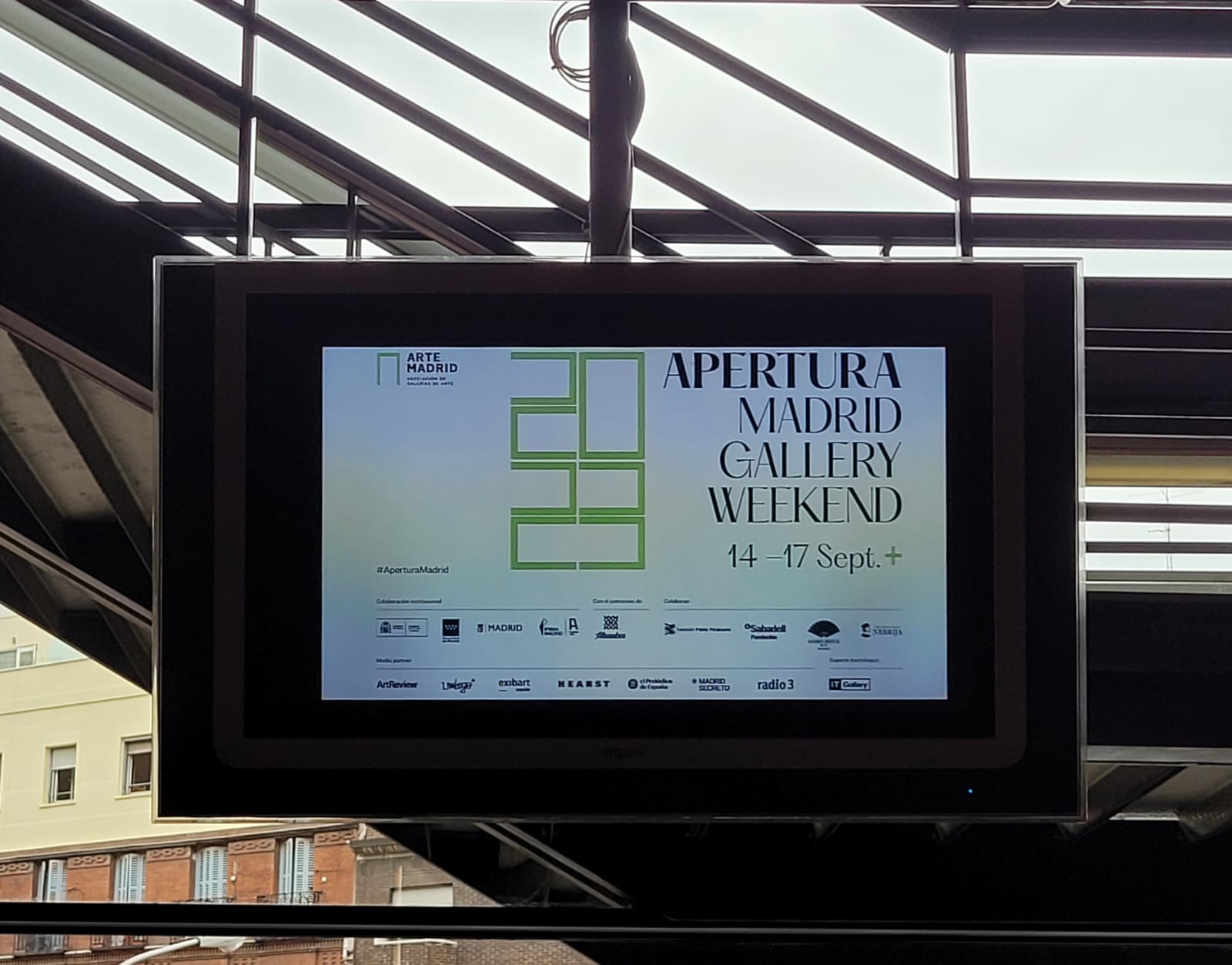 Opening
Opening

The tour can begin at Maisterravalbuena and the solo exhibition Campos poéticos by Swiss artist Silvia Bächli (Baden, 1967). Twenty gouache works on paper, of different formats and periods, including recent works that will be exhibited for the first time. The exhibition layout, designed by the artist herself, borrows display strategies from installation as an artistic genre and is a key component of the work, through which she emphasizes the importance of the viewers’ physical experience. Bächli makes subtle and noninvasive two-dimensional interventions, creating the conditions for the encounter with the artwork as an environment: in the relationship between drawings and architecture, visual gaps are also evident, however loaded with information, namely the memory of the movement of the artist’s body when she paints, present in the invisible continuity of the harmonic proportions and rhythm of the strokes. Bächli’s work is repetition, representation and presence of the body, where the artist uses line and plane as a poetic synthesis of expressive bases, and where the dimensions of the paper convey the organic limits of physical gestures during the creative process, from from the performative act, to the design and staging of the exhibition. Helga de Alvear ’s is exhibiting German Jürgen Klauke (Kliding, 1943) with Kreuz & Queer: the work of the Cologne-based artist raises the question of gender difference in an often even radical way, and here he does so with drawings where everything is intertwined and entangled, founded on an aesthetic of black and white, space and void, forms inscribed in figurations, which overlap them, divide them and connect them at the same time and seem to have a “transformative” function: what looks like white on the outside is black on the inside and vice versa. They thus play the paradoxical role of revealing by concealing. Viewed as a whole, the drawings reveal a complex interplay of positive and negative polarities, of concrete or fragmented corporeity, of erotically charged motifs and deindividualized components, from within and without.
From Juan Silió , on the other hand, here is home-grown artist Belén Rodríguez (Valladolid, 1981) with I danced myself out of the womb: works that arise from the artist’s contact with nature. Many of her works are composed of fabrics dyed with natural forest elements: oak, eucalyptus, chestnut, birch, walnut, laurel... Through the diaries of each color trial, halfway between a herbarium and a textile sampler, and by means of the works in which the fabrics delicately weave the frame, Rodríguez creates a portrait of the forest and, at the same time, his work picks up the legacy of painting and sculpture as art, translating it to what he believes are the needs of today, telling of a life that must remain wild and free. More Spanish art at Galería Silvestre where we visit Los cuerpos inesperados by Vicente Blanco (La Coruña, 1974), an exhibition in which the artist presents his new work that continues to explore questions about changes in the territory, landscape and nature of the rural world in which he lives. In his work, these questions are also raised by a perspective on the construction of male identity that, beyond a vision of domination, reexamines it to create other imagery with which to confront a resistance to his environment. His drawings present an interconnected sensory world, where the pencil stroke accommodates, like a skin, the beings and bonds, but also the violence that inhabits it.


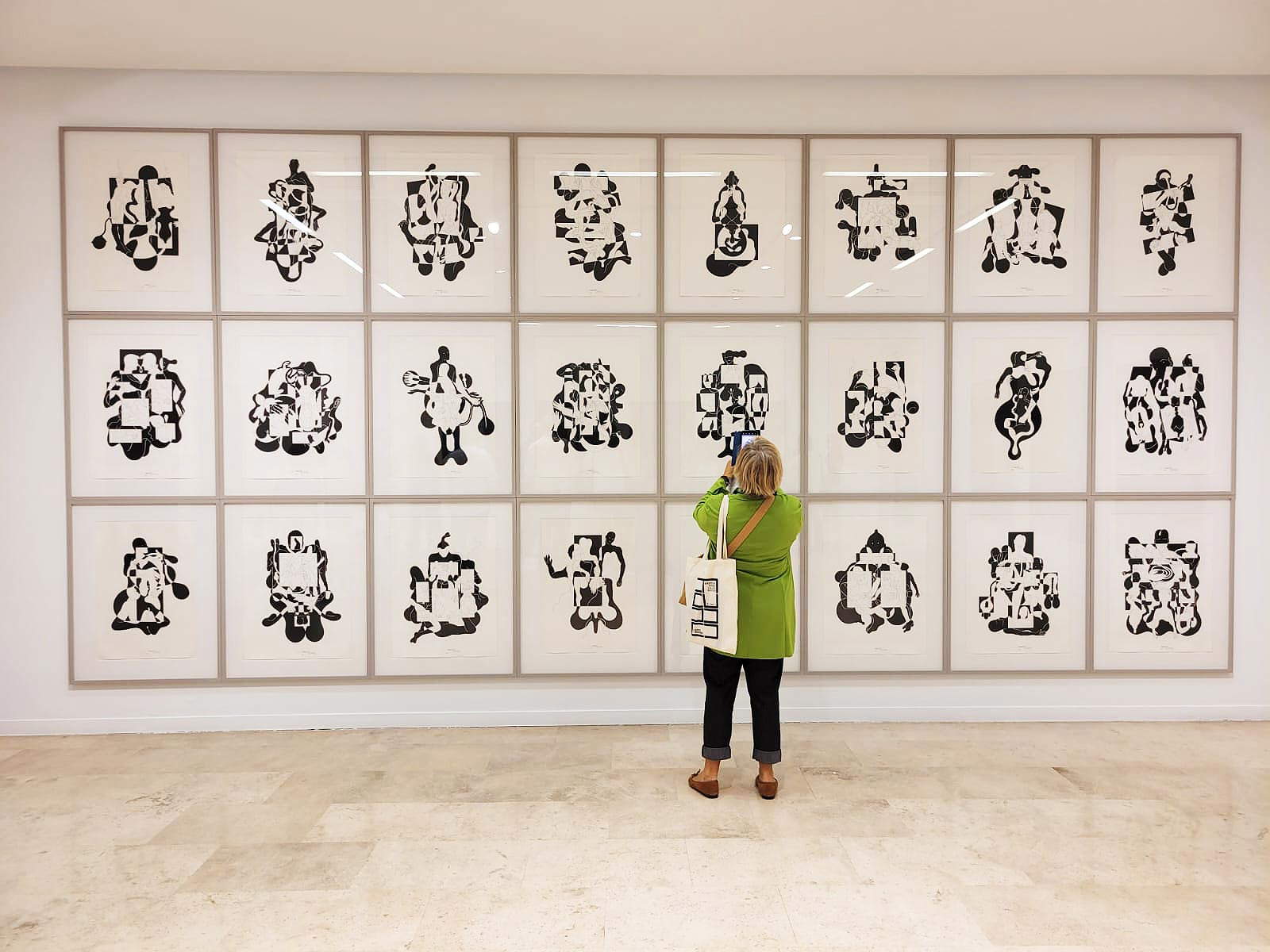



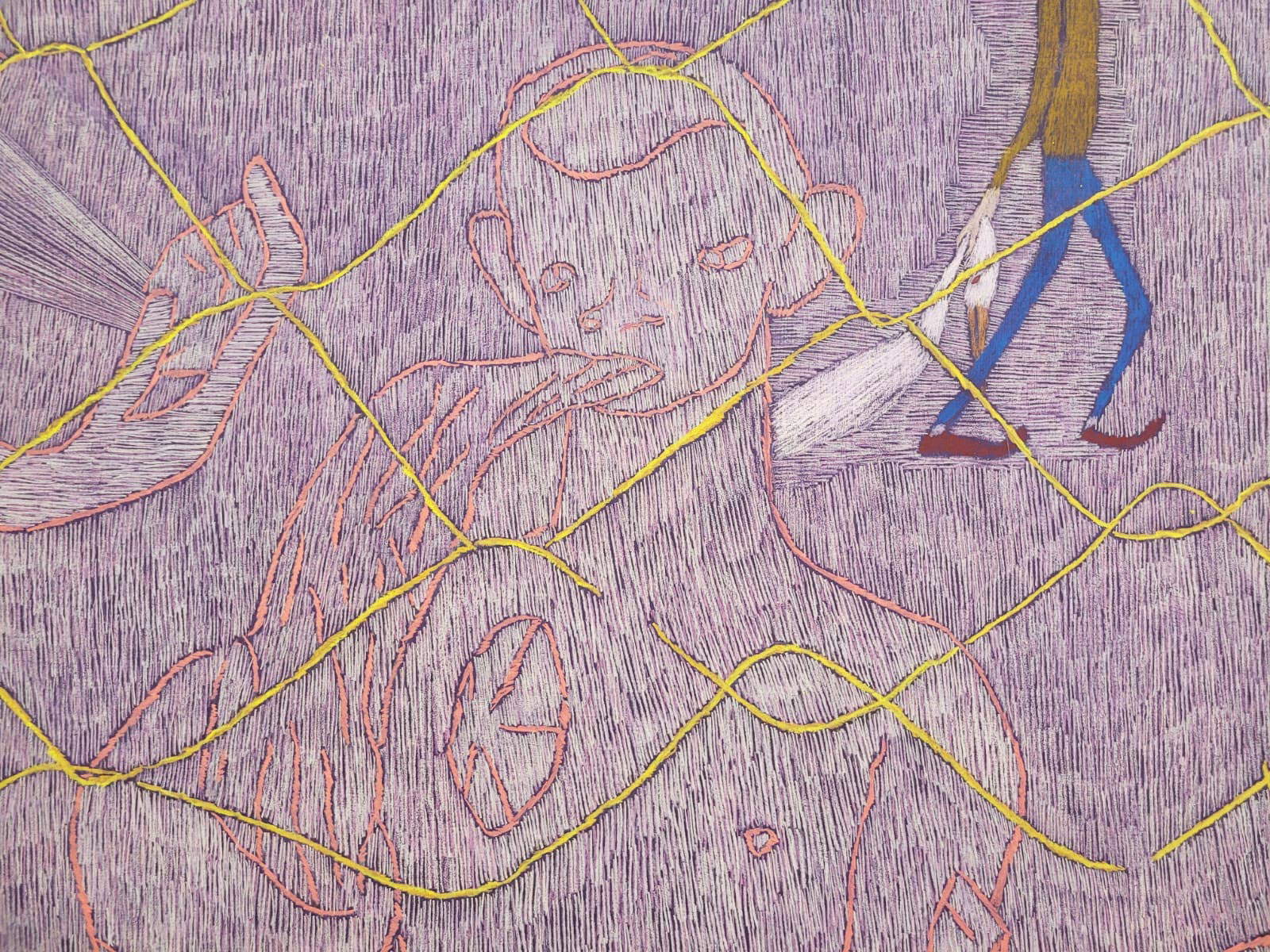

Pere Llobera ’s (Barcelona 1970) exhibition Mecanismos del humor , at F2 Galería, is singular: an exhibition that is a “comic release,” as the artist calls it, something “very similar to those inappropriate jokes in the last rows of funerals with which we support reality in messy moments.” According to Llobera, a day without humor is a day wasted, as Buñuel said.The exhibition therefore explores the reasons behind humor, tries to understand why it is so important, not only for the artist (“when my son laughed for the first time I could breathe easily,” he says), but also for all of us. From Spain we move on to South America with Chilean-Peruvian artist (but Portuguese by birth) Ivana de Vivanco (Lisbon, 1989), who presents her solo show La yegua de Santiago at The Ryder gallery: the exhibition starts from the assumption that historical narratives have always been fueled by the epic of a warrior and aristocratic class (heroes winning battles on horseback, kings fighting other kings, and so on). Gradually, this epic of violence and abuse settled into our history of the past, leading us to think that this way of “making history” was the only one possible. With La Yegua de Santiago, Ivana de Vivanco invites us to think. maybe we were wrong. And she does so with paintings that resonate with Latin American baroque, blending theatrical scenes with mysterious atmospheres filled with metaphors and sociopolitical references.
Galería Marta Cervera , on the other hand, presents an artist from the past, American Bob Smith (Robert B. Smith; Springfield, 1944 - Miami, 1990): with the exhibition Días de oro y plata, works made during Bob Smith’s long stay in Madrid are exhibited, namely drawings, engravings, objects and canvases in which personal experiences and emotions from his travels through Europe and the Middle East are crystallized. Smith, after traveling through Europe and spending a year in Morocco where he learned the craft of wood and silver inlay, decided to settle and work in Madrid. His work thus came to Galeria Vandrés, an important hub of the avant-garde in the 1970s. During that decade the artist exhibited regularly in Spain, France, Germany and Italy and was included in the 1973 Paris Biennale at the Musée d’Art Moderne. He received numerous awards, including the Pollock-Krasner Foundation Fellowship, and in 2022, a retrospective of his work took place at the Martos Gallery in New York. Instead, it is Inmaculada Salinas (Guadalcanal, 1967) who is the protagonist at Gallery 1 Mira Madrid with the exhibition La voz a ti debida, which speaks of themes dear to the artist, starting with that of work. Indeed, Salinas wants to raise fundamental questions about the emancipation of labor and violence, leveraging elements and images drawn from reality and drawings and calligraphic exercises that, repeated over and over again, shape a narrative about the factors that led to this situation and its consequences. These works, which represent one of the most extensive and complex series in his overall production, are exercises in memory and autobiography. They speak of manual labor as a way of thinking, of resistance to any logic of capital production, of the economic conditions associated with it, of the dynamics of studying outside the studio and of time spent working. And also about the right to laziness and doodling as a masterpiece.



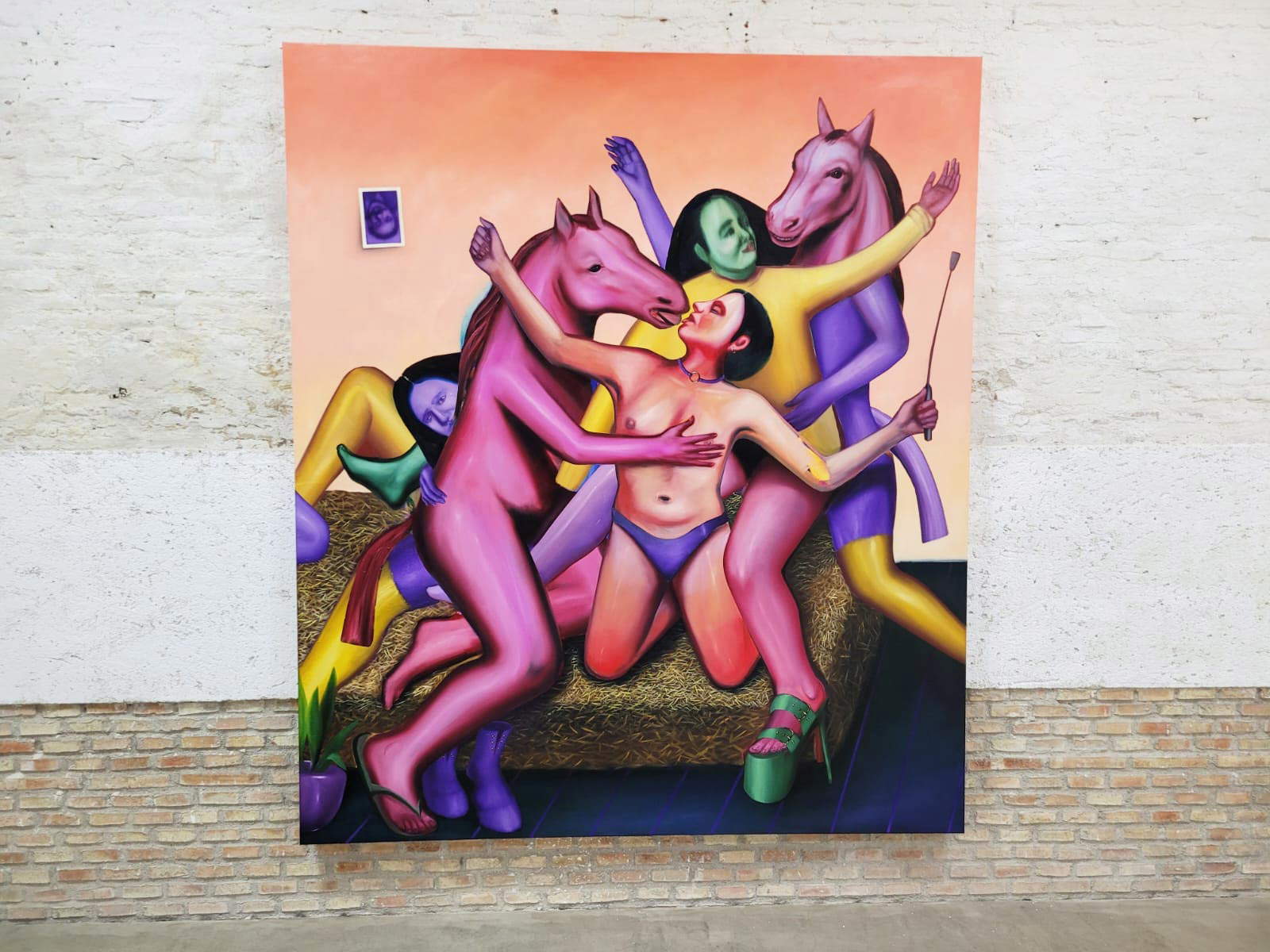




Rosa Santos presents the exhibition Y septiembre es claro y azul de nuevo by the young María Tina ut (Valladolid, 1991): this is María Tinaut’s second solo show at Rosa Santos Gallery, the first at the Madrid location. On this occasion the artist her new works that lie between photography and painting. In this body of work, the shifting and blurring of the fundamentals of representation in photographic and pictorial languages is intended to raise questions about authorship. Instead, it is Madrid-based Santiago Giralda (Madrid, 1980) who is exhibiting at MPA Moisés Pérez de Albéniz with the exhibition Los años luz. The artist paints landscapes from images he takes with his camera or collects from the Internet. Giralda’s compositions highlight the idea of the contemporary landscape as a cultural construction, where the multitude of images, texts and references that define it are more relevant than its very nature. “The project,” the artist himself explains, “reflects on the position that nature occupies in the contemporary context, where pre-designed spaces replace natural conditions. In the urban environment, the natural becomes unnatural. On a pictorial level, I depict landscapes to establish hypotheses about how this change has affected our perception of the environment and the artifacts that pass through it. Painting allows me to connect my images with history. Through an intense painting process I emphasize the physical and temporal aspect of painting, as matter modulated manually over time. Therefore, I intend to provoke an experience in which the viewer finds a moment of contemplation away from the noise of the media.”
Mexican Moris (Israel Meza Moreno; Mexico City, 1978) exhibits at NF / Nieves Fernández with La cárcel a cielo abierto, Moris’ third solo exhibition at the gallery. The artist uses the social foundations of his work to highlight problems such as migration, poverty, impunity or corruption. These problems, despite their gravity, have been normalized to the point of seeming natural, challenging the shared notion of freedom. In recent years, Moris’ practice has shifted toward opposition, which has allowed his work to situate itself in a new terrain of shocking convergence between centuries of power, poverty and societies in the process of reconstruction. The exhibition presents a collection of images from different genealogies with the aim of making the multiverse visible and expanding the meaning of visual language. Instead, it is a pair of female artists exhibiting at the Lucía Mendoza Gallery: Barbara Fluxá (Madrid, 1974) and Lucía Loren (Madrid, 1973) are the protagonists of Producir mundo entre redes y marañas, an exhibition in which the two artists investigate how the human processes that produce the “world” are absolutely interdependent on the systemic relationships that sustain the web of life. Fluxá and Loren propose, through a relational perspective, to see landscape as that web of organisms, ecosystems and geochemical cycles that make up the Earth. Their multidisciplinary installations produced through videos, drawings, photographs, interventions, sculptures and natural materials focus on promoting and claiming this network of interdependencies. An expanded network of creativity between humans and nonhumans that now more than ever we must keep in balance.




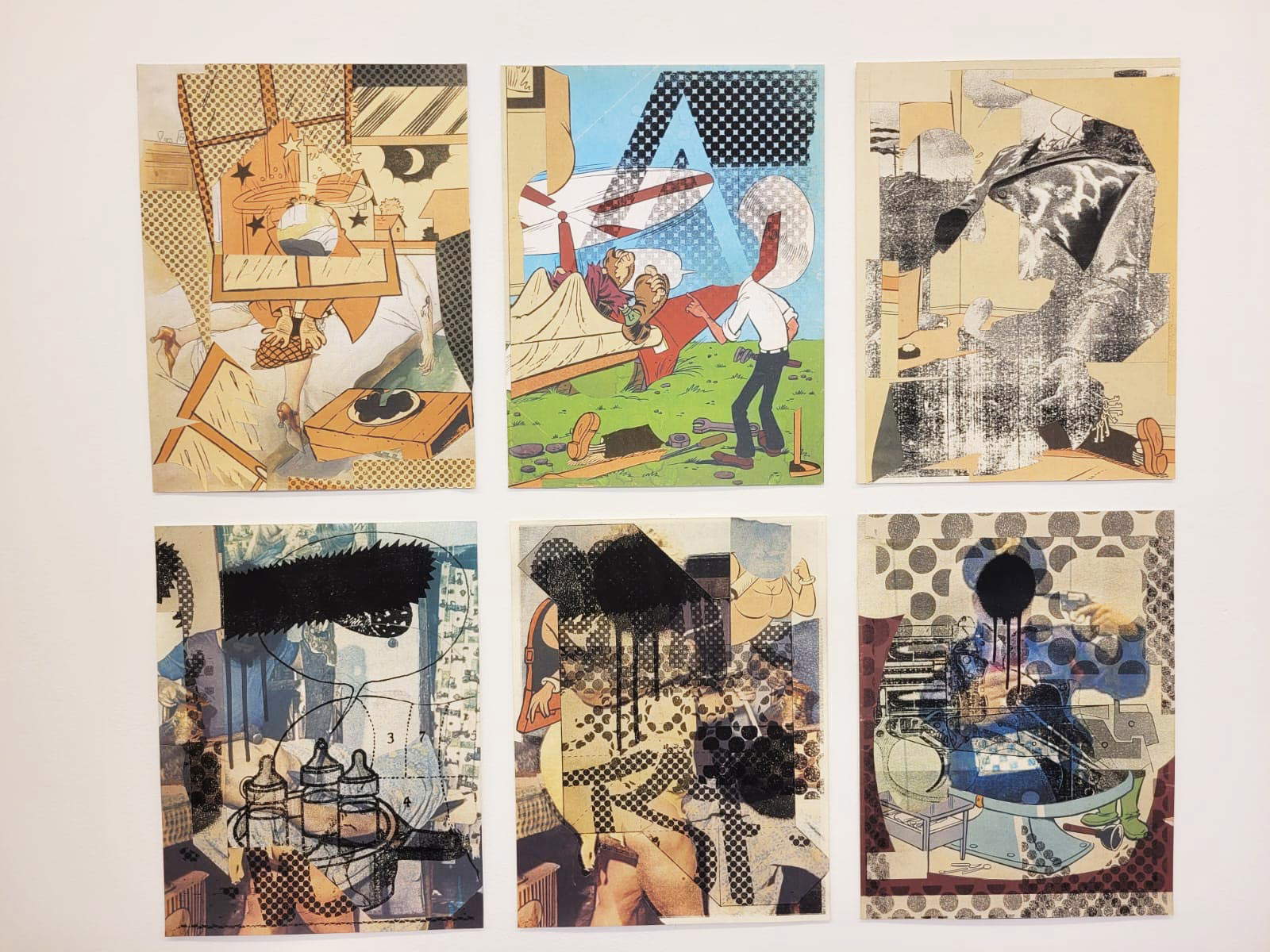
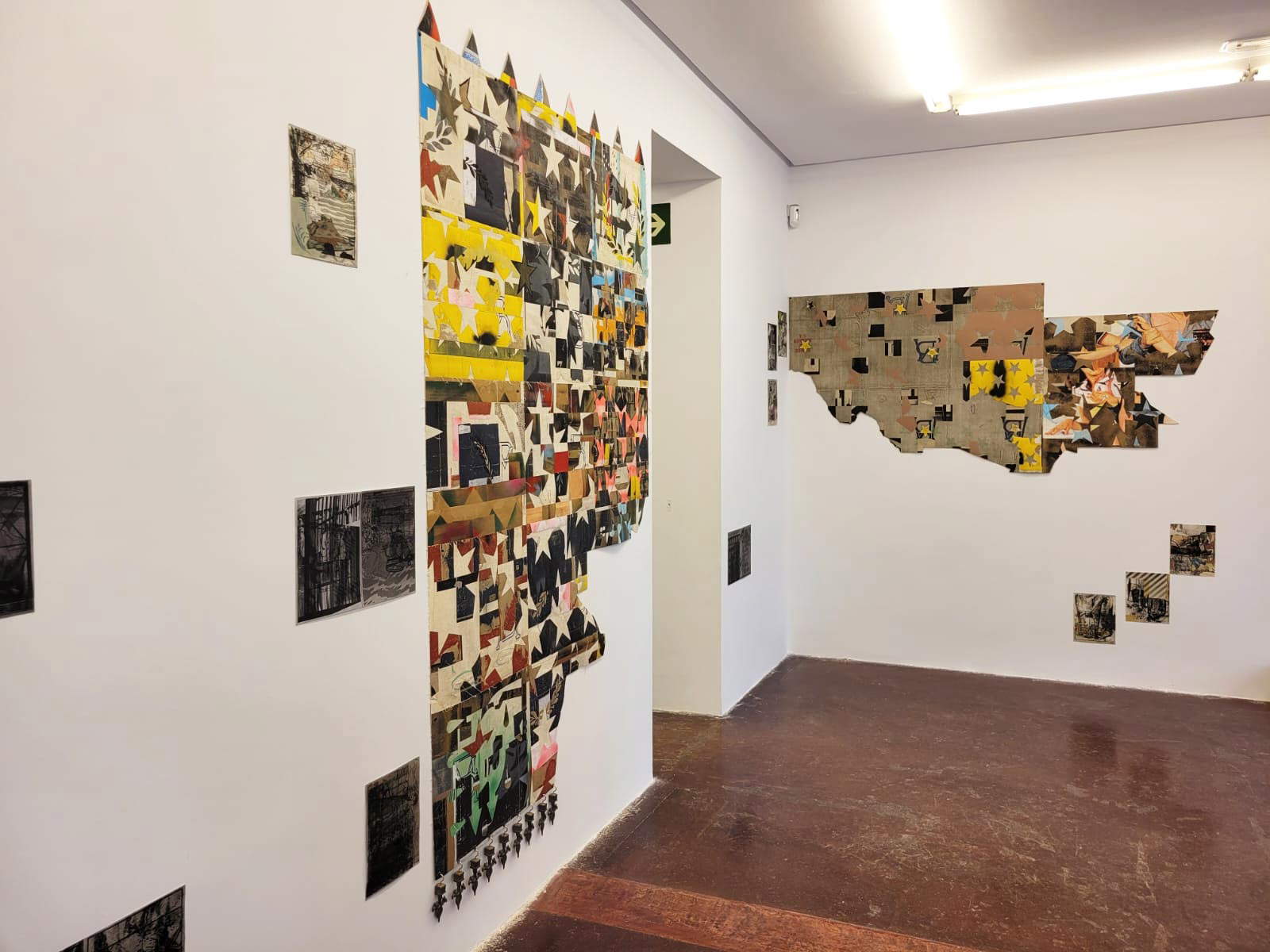


An internationally renowned Spanish artist exhibits by Daniel Cuevas: he is José Manuel Ballester (Madrid, 1960), with Universo Bipolar, which came about as a result of Ballester’s recent travels to countries such as Brazil, China, Cuba, and Russia (all, therefore, in the communist orbit), and he has observed how these places appear marked by a political, social, and economic situation, which he calls “bipolar.” That is, they are countries in constant pursuit of change, of evolution of all their institutional spheres, but seen to our eyes they seem to be in perpetual “involution” in all their spheres. In this exhibition, Ballester thus presents his vision of the situation of these countries in continuous construction/destruction through the architecture and infrastructure of the cities he has visited all these years, such as Havana, Brasilia or Moscow. Another established painter, the Cuban Ariel Cabrera (Camagüey, 1982), is exhibiting at Álvaro Alcázar with Zonas húmedas, a monographic exhibition in which the artist presents together all the series he has made simultaneously throughout his career and where pleasure appears as a leitmotif. Cabrera’s work encompasses endless stories and meanings derived from the artist’s imagination, always having as its basis the theme of Cuban history. Through a reinterpretation of historical archives, closer to a filmmaker than a painter, Cabrera composes what might seem to be a collage between “clippings” of old photographs and scenes of carefree fun. From this dualism comes his so-called “neo-historicism”: his characters have playful and carnal desires, are less military and more human, coming closer to pornographic postcards than to the heroes of traditional Cuban painting. Underlying Cabrera’s work is a deep knowledge of the history of his native country, as well as his past as a collector of nineteenth-century tablets, period newspapers and photographs, and travel books, to which is added his great passion for Italian cinema. All these ingredients serve as a formal resource to develop a style based on rich chromaticism, contrasts of light and color, and different planes.
We Collect gallery, on the other hand, offers a young man: Romain Blanck (Düsseldorf, 1995), with Faux raccord, presents recent paintings in which the artist selects familiar graphic shapes, lines, signs, faces and symbols found on sheets of paper collected in art supply stores and others directly on social media applications. There is a sense of urgency everywhere, dictated by Internet-based elements and the repetition of the same image and forms in various paintings, which reinforce the artificial spontaneity of the works. In the exhibition space, two green walls house some paintings, recalling the color of a green screen on which any element taken from another source can be placed, just as it is within the paintings. One can recognize in Romain Blanck’s painting something very familiar, but also something that fails, as happens with the expression “false friend,” which warns that one could mistranslate a word because of its formal similarity to our. language." Finally, space is given to photography with Artist as clown by the established Finnish artist Elina Brotherus (Helsinki, 1972) at Camara Oscura: “After 20 years of ’using myself’ in my photographs, I felt like I had done all the poses I could do with my body,” says the artist. The way out of this dead end came through the rediscovery of Fluxus. In 2016, on the occasion of his nomination for the Prix Elysée, Brotherus began using scores from Fluxus events and other instructions for artists as the basis for his work. The Meaningless Work series on which this exhibition is based is still a project in progress: the series allows her to make new discoveries, all while continuing to do what she knows best. Brotherus today is among the best-known Finnish artists: her work has alternated between autobiographical and art-historical approaches.




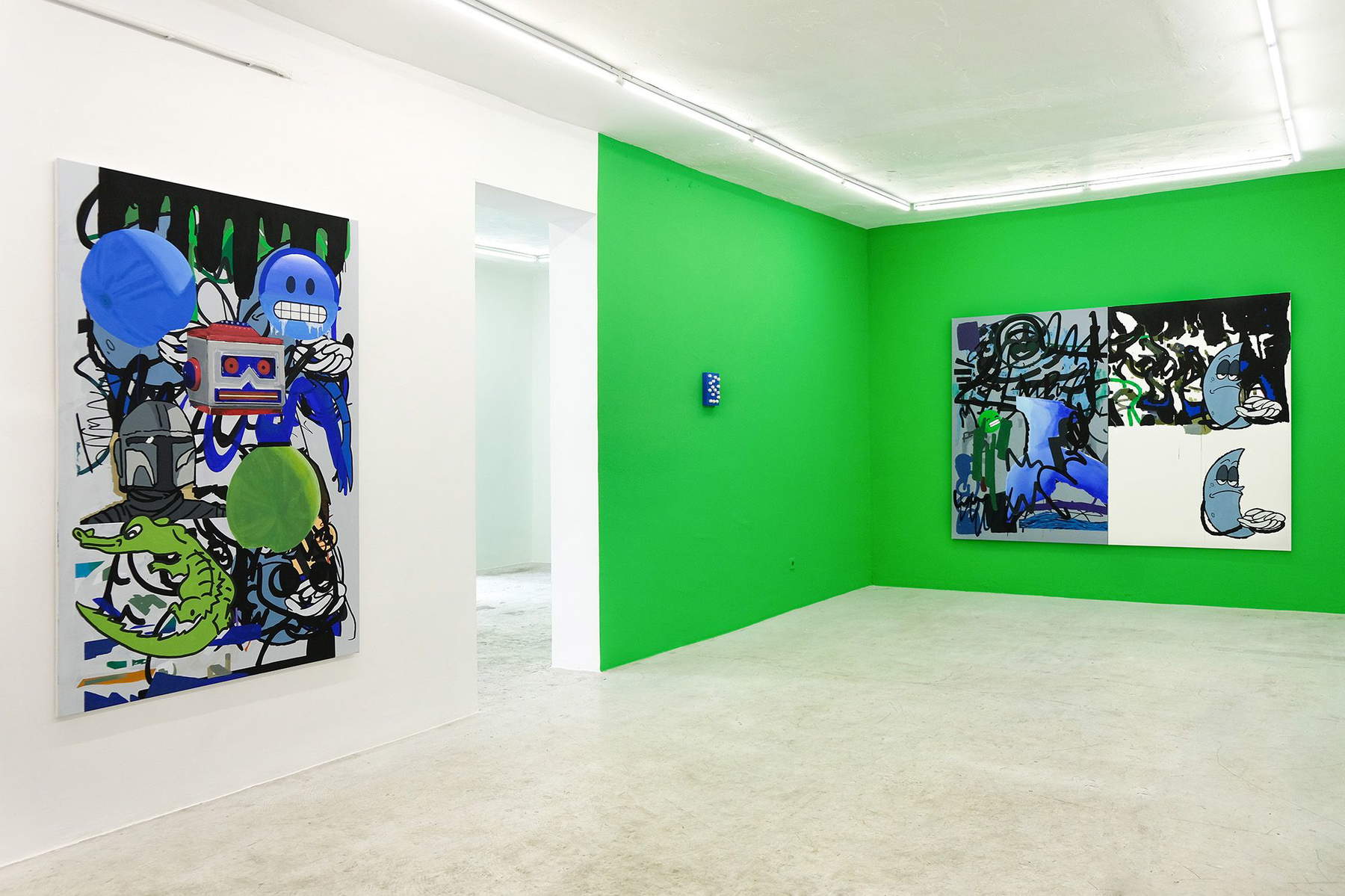

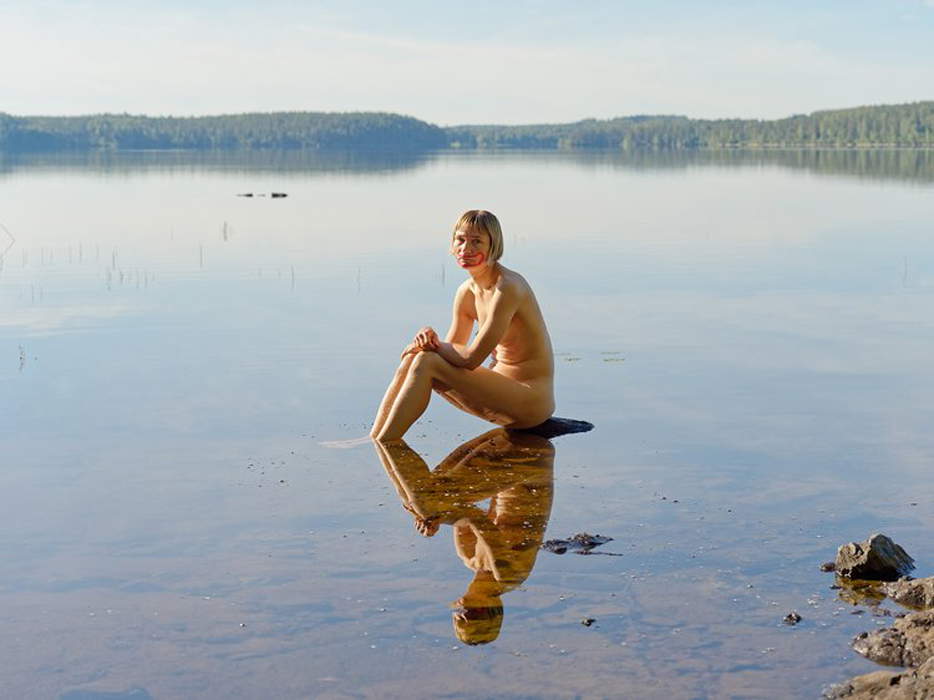

Warning: the translation into English of the original Italian article was created using automatic tools. We undertake to review all articles, but we do not guarantee the total absence of inaccuracies in the translation due to the program. You can find the original by clicking on the ITA button. If you find any mistake,please contact us.